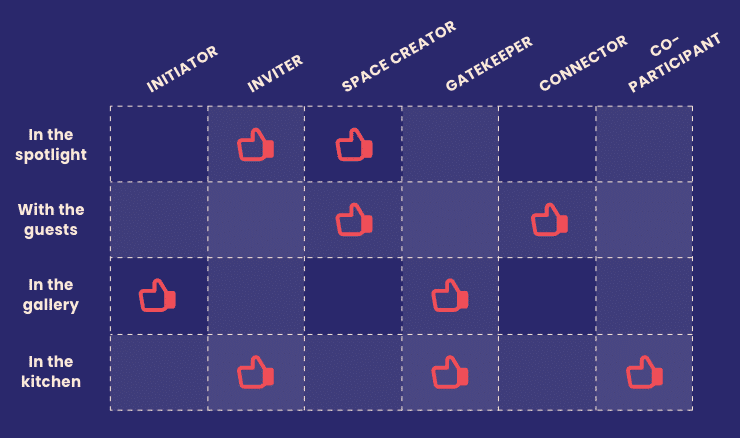Chances are you’ve already heard a lot about the two predominating leadership styles: heroic leadership and servant leadership. Hero leaders are the ones who step into the spotlight and lead from there. Servant leaders, on the other hand, lead their followers from the background by serving them. Naturally, the kind of relationship between leaders and followers that emerges from these leadership styles is very different. But what if there was a more flexible leadership model that would allow for you to step forward and back as needed?
Host Leadership: be my guest
Mark McKergow and Helen Bailey developed a new leadership style called Host Leadership. The name says it all: you, as a leader, act like a host. A host is always a person who builds, and takes care of, relationships. Contrary to other models, Host Leadership doesn’t put the leaders themselves in the center, but rather their ability to build relationships and establish connections with other people.
“A host leader is someone who engages fellow participants in a purposeful endeavor.”
Mark McKergow & Helen Bailey
A leader’s dilemma
All leaders find themselves in impossible situations where contradictory expectations and requirements have to be met. As leaders, we’re constantly pulled into two opposed directions. We stand between our employees and the organization—and need to serve both.
The 6 roles of Host Leadership
The new leadership model attempts to bridge this gap and solve the typical dilemma leaders are facing around the globe. In doing so, Host Leadership is all about roles, not rules. Roles a leader can take on and swap as needed, instead of strict rules which need to be followed all the time. Six roles, to be specific, which can be taken on in four different situations, two of which cover the “step forward” and two the “step back” scenarios mentioned above.
Let’s get the party started!
Let’s have a look at the different roles of Host Leadership:
- Initiator
First of all, the host acts as an initiator and determines what’s needed to set the frame for a successful party.Then, the actual planning starts and first steps are taken. - Inviter
In the next step, the host decides who will be invited to the party. This requires both a step forward (the act of inviting) and a step back (leaving others the choice to accept or decline). At the same time, the host shows appreciation towards his or her guests. - Space Creator
Now it’s time to create a welcoming space that caters to the needs of all guests. Hosts take care of all the details and try to plan everything in advance, then take a step back at the party, but are ready to step forward again in case they are needed. - Gatekeeper
As a host, you welcome your guests and keep an overview of the situation. If something goes in an undesired direction, it’s usually the host who steps in to “save the day” and lead people out of it. Other tasks are to draw boundaries or to foster progress. - Connector
Everyone knows the typical image of the host talking to all the guests (connecting with people) and introducing people to each other (connecting people). A good host makes sure nobody is left out. He/she builds connections between people without choreographing the entire interaction. - Co-Participant
As a participant of one’s own party, the host is present and enjoying the party, yet needs to switch between the leading and the serving role: sometimes he/she is providing direction, whereas in other moments it’s necessary to take a step back and allow the guests to be served first. As Simon Sinek aptly put it: leaders eat last.
The 4 positions of a host leader
A good host also recognizes the value of the following four positions and is able to change his or her spot as needed. A good leader does the same—here’s how this might look at work:
- In the spotlight: You’re in the focus, you lead the group.
→ when representing your team or organization; when holding a presentation; when facilitating a workshop - With the guests: You mingle with your guests, are present, but not in the limelight.
→ when attending a meeting/event; when joining a discussion; when having lunch with your team - In the gallery: You’re in the background, keeping an eye on the situation.
→ when stepping back from everyday work; when having a look at the big picture; when working on a strategy for the future - In the kitchen: You’re in a private space, preparing or reflecting.
→ when talking to your own coach/mentor; when organizing offsite events; when meeting with leaders from other organizations; when practicing mindfulness
Now, how can you apply Host Leadership at work?
The best thing about Host Leadership is that you can apply the roles at any level of an organization: as a team leader, as a project leader, when collaborating with others, when working with suppliers or customers, when working with patients, learners or other service users.
Here’s a little “cheat sheet” of combinations of roles and positions to help you figure out what makes most sense in which situation:
Host Leadership applied at work
A few examples of how these combos look like “in real life:”
- Inviter in the spotlight:
when presenting a new project and asking who wants to be on the project team - Space Creator in the spotlight:
when explaining the purpose of a meeting; when appreciating the work of the team - Space Creator with the guests:
when helping your team create the space necessary for a certain project or task - Gatekeeper in the gallery:
when observing a meeting and deciding whether to step in or not - Connector with the guests:
when fostering collaboration between two meeting participants to find a solution to a problem together - Co-Participant in the kitchen:
when preparing a meeting and your own arguments
Which kind of host are you?
You just learned a lot about Host Leadership. And we’re sure you’ve already taken on several of the roles mentioned above.
Take a moment to think about which roles you usually fill, and which roles you shy away from or probably never even thought of. And then… just try them out!
Roland Mayer
Email: roland.mayer@leaders21.com
Link to profilepage


